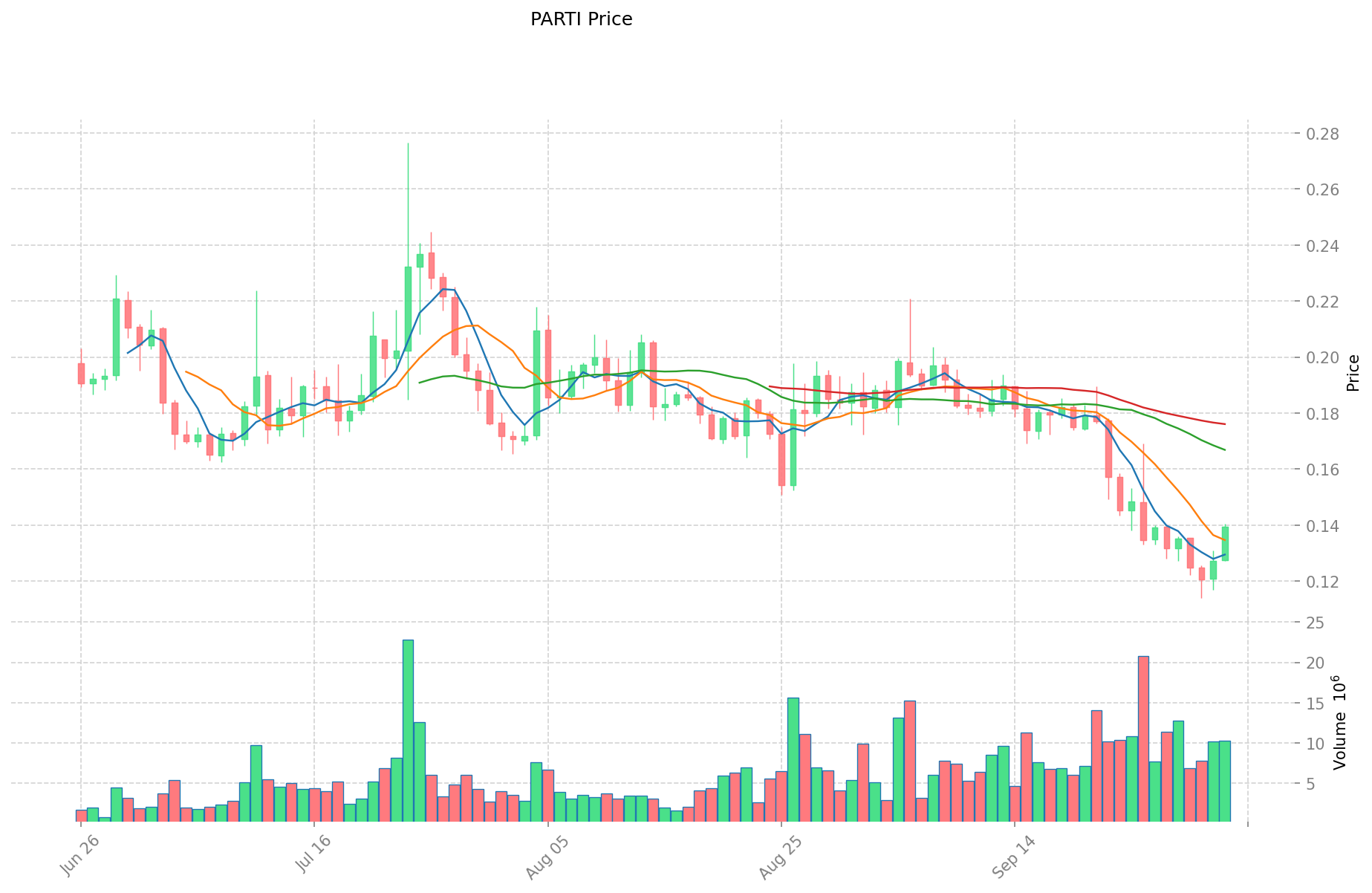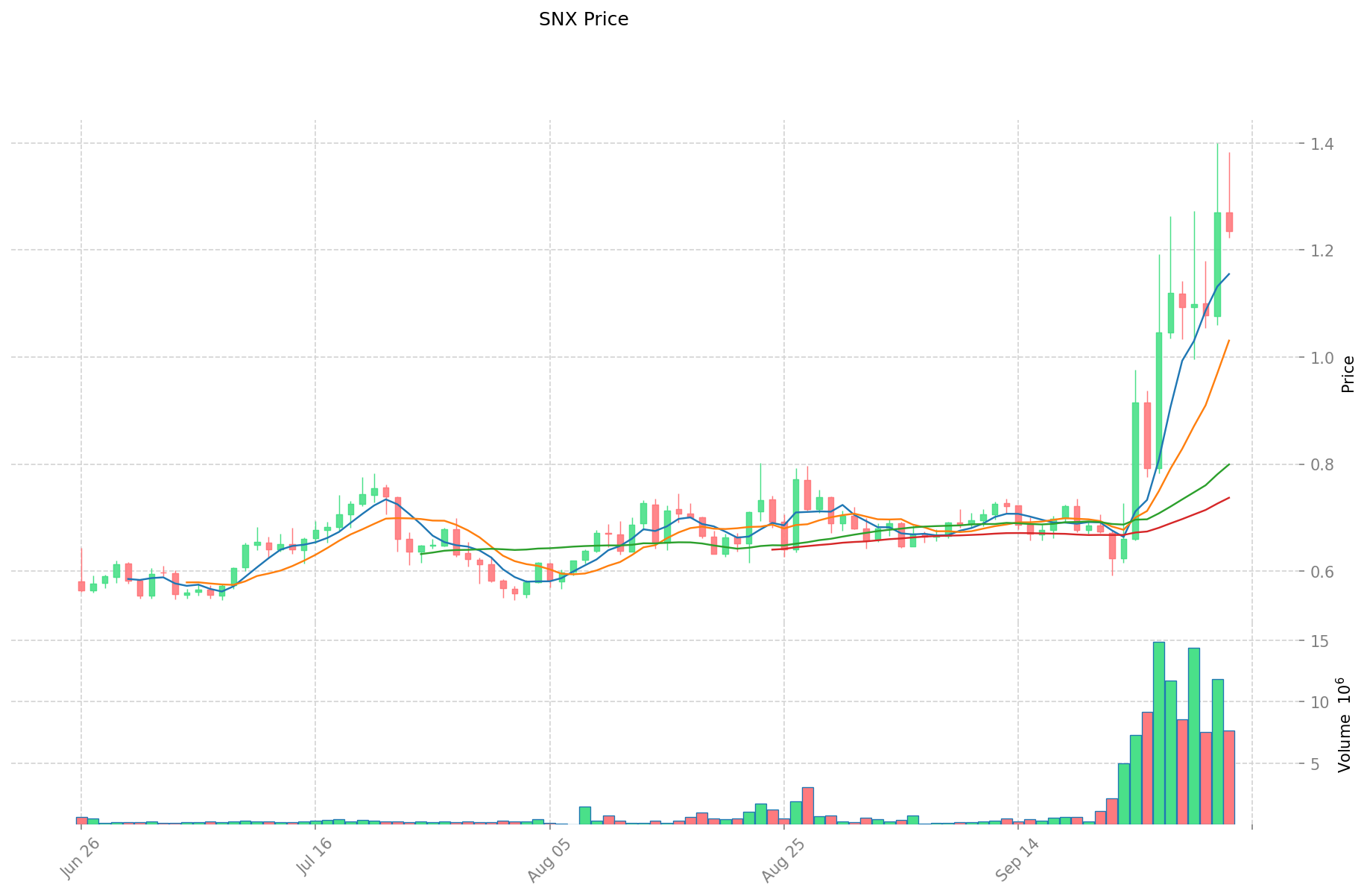PARTI vs SNX: Comparing Advanced Image Generation Models for Enterprise Applications
Introduction: Investment Comparison between PARTI and SNX
In the cryptocurrency market, the comparison between Particle Network vs Synthetix has been an unavoidable topic for investors. The two not only show significant differences in market cap ranking, application scenarios, and price performance but also represent different positions in crypto assets.
Particle Network (PARTI): Since its launch, it has gained market recognition for its leading chain abstraction infrastructure in Web3.
Synthetix (SNX): Since its inception in 2018, it has been hailed as a platform designed for engineers to build decentralized and untrusted networks, supporting a variety of synthetic assets.
This article will comprehensively analyze the investment value comparison between PARTI vs SNX, focusing on historical price trends, supply mechanisms, institutional adoption, technological ecosystems, and future predictions, attempting to answer the question investors care about most:
"Which is the better buy right now?"
I. Price History Comparison and Current Market Status
PARTI (Coin A) and SNX (Coin B) Historical Price Trends
- 2025: PARTI experienced a significant price drop, reaching its all-time low of $0.11382 on September 30.
- 2021: SNX reached its all-time high of $28.53 on February 14, driven by the DeFi boom.
- Comparative analysis: In the recent market cycle, PARTI dropped from its all-time high of $0.44305 to $0.13358, while SNX declined from its peak to the current $1.2033.
Current Market Situation (2025-10-03)
- PARTI current price: $0.13358
- SNX current price: $1.2033
- 24-hour trading volume: PARTI $1,374,109.93 vs SNX $4,826,765.18
- Market Sentiment Index (Fear & Greed Index): 64 (Greed)
Click to view real-time prices:
- Check PARTI current price Market Price
- Check SNX current price Market Price


Investment Value Analysis: PARTI vs SNX Core Factors
Supply Mechanism Comparison (Tokenomics)
- PARTI: Limited information available; notable for significant token unlocking events, with approximately $34 million worth of tokens scheduled for unlock recently
- SNX: Core token of Synthetix platform, used for staking to provide liquidity for synthetic spot and perpetual markets
- 📌 Historical pattern: PARTI's value appears heavily influenced by token unlock schedules, while SNX value is tied to platform utility and staking mechanisms.
Institutional Adoption and Market Applications
- Institutional holdings: SNX demonstrates stronger institutional interest through its established synthetic asset platform
- Enterprise adoption: SNX offers risk diversification and enhanced returns through synthetic assets, creating broader application potential
- Regulatory stance: Limited information available on specific regulatory attitudes toward either token
Technical Development and Ecosystem Building
- SNX technical upgrades: Synthetix V3 introduces multi-collateral staking as a core principle, expanding beyond SNX-only staking
- SNX ecosystem innovation: Implementation of vault design where each vault is comprised of a specific collateral token
- Ecosystem comparison: SNX has more established DeFi applications through its synthetic asset platform, allowing investors to diversify risk across multiple asset types
Macroeconomic and Market Cycles
- Inflation environment performance: SNX's synthetic asset platform potentially offers inflation hedging through diverse asset exposure
- Macroeconomic factors: Limited specific information on how monetary policy affects either token
- Cross-border considerations: SNX's synthetic assets platform potentially "breaks financial boundaries" by providing global access to various asset classes
III. 2025-2030 Price Prediction: PARTI vs SNX
Short-term Prediction (2025)
- PARTI: Conservative $0.0760-$0.1334 | Optimistic $0.1334-$0.1534
- SNX: Conservative $1.0098-$1.2022 | Optimistic $1.2022-$1.3224
Mid-term Prediction (2027)
- PARTI may enter a growth phase, with prices estimated at $0.0889-$0.2047
- SNX may enter a consolidation phase, with prices estimated at $0.9614-$1.6117
- Key drivers: Institutional capital inflow, ETFs, ecosystem development
Long-term Prediction (2030)
- PARTI: Base scenario $0.2309-$0.2409 | Optimistic scenario $0.2409-$0.2505
- SNX: Base scenario $1.3242-$1.7197 | Optimistic scenario $1.7197-$2.3904
Disclaimer
PARTI:
| 年份 | 预测最高价 | 预测平均价格 | 预测最低价 | 涨跌幅 |
|---|---|---|---|---|
| 2025 | 0.1533985 | 0.13339 | 0.0760323 | 0 |
| 2026 | 0.192148295 | 0.14339425 | 0.1218851125 | 7 |
| 2027 | 0.20468095245 | 0.1677712725 | 0.088918774425 | 25 |
| 2028 | 0.230920379469 | 0.186226112475 | 0.1080111452355 | 39 |
| 2029 | 0.27323095222332 | 0.208573245972 | 0.156429934479 | 56 |
| 2030 | 0.250538183061566 | 0.24090209909766 | 0.231266015133753 | 80 |
SNX:
| 年份 | 预测最高价 | 预测平均价格 | 预测最低价 | 涨跌幅 |
|---|---|---|---|---|
| 2025 | 1.32242 | 1.2022 | 1.009848 | 0 |
| 2026 | 1.5652644 | 1.26231 | 1.1991945 | 5 |
| 2027 | 1.611717408 | 1.4137872 | 0.961375296 | 17 |
| 2028 | 1.55813487312 | 1.512752304 | 0.89252385936 | 25 |
| 2029 | 1.9039500498144 | 1.53544358856 | 1.074810511992 | 27 |
| 2030 | 2.390378578670208 | 1.7196968191872 | 1.324166550774144 | 43 |
IV. Investment Strategy Comparison: PARTI vs SNX
Long-term vs Short-term Investment Strategies
- PARTI: Suitable for investors focused on Web3 infrastructure potential
- SNX: Suitable for investors interested in DeFi and synthetic asset exposure
Risk Management and Asset Allocation
- Conservative investors: PARTI: 20% vs SNX: 80%
- Aggressive investors: PARTI: 40% vs SNX: 60%
- Hedging tools: Stablecoin allocation, options, cross-currency portfolios
V. Potential Risk Comparison
Market Risk
- PARTI: Volatility associated with token unlocking events
- SNX: Exposure to synthetic asset market fluctuations
Technical Risk
- PARTI: Scalability, network stability
- SNX: Smart contract vulnerabilities, liquidity risks
Regulatory Risk
- Global regulatory policies may impact both tokens differently, with potential scrutiny on synthetic assets affecting SNX
VI. Conclusion: Which Is the Better Buy?
📌 Investment Value Summary:
- PARTI advantages: Leading chain abstraction infrastructure in Web3
- SNX advantages: Established synthetic asset platform with diverse applications
✅ Investment Advice:
- New investors: Consider a small allocation to SNX for exposure to DeFi
- Experienced investors: Balanced portfolio with both PARTI and SNX, adjusting based on risk tolerance
- Institutional investors: Evaluate SNX for its established ecosystem and potential for synthetic asset diversification
⚠️ Risk Warning: The cryptocurrency market is highly volatile. This article does not constitute investment advice. None
FAQ
Q1: What are the main differences between PARTI and SNX? A: PARTI is focused on leading chain abstraction infrastructure in Web3, while SNX is an established platform for synthetic assets in DeFi. PARTI has experienced significant price volatility recently, while SNX has a longer track record in the market since 2018.
Q2: Which token has shown better price performance recently? A: Based on the current data, SNX is trading at a higher price ($1.2033) compared to PARTI ($0.13358). However, both tokens have experienced significant drops from their all-time highs, with PARTI dropping from $0.44305 and SNX from $28.53.
Q3: How do the supply mechanisms of PARTI and SNX differ? A: PARTI's supply mechanism is notably influenced by token unlocking events, with a recent $34 million worth of tokens scheduled for unlock. SNX, on the other hand, is used for staking to provide liquidity for synthetic spot and perpetual markets on the Synthetix platform.
Q4: What are the key factors driving institutional adoption for these tokens? A: SNX demonstrates stronger institutional interest due to its established synthetic asset platform, which offers risk diversification and enhanced returns. PARTI's institutional adoption is less clear based on the provided information.
Q5: How do the ecosystem developments compare between PARTI and SNX? A: SNX has a more established ecosystem with its synthetic asset platform and recent upgrades like Synthetix V3, which introduces multi-collateral staking. PARTI's ecosystem development is focused on Web3 infrastructure, but specific details are limited in the provided information.
Q6: What are the long-term price predictions for PARTI and SNX? A: By 2030, PARTI is predicted to reach $0.2309-$0.2505 in the base to optimistic scenarios. SNX is predicted to reach $1.3242-$2.3904 in the same timeframe. However, these predictions are subject to market volatility and should not be considered as financial advice.
Q7: How should investors approach allocating between PARTI and SNX? A: Conservative investors might consider allocating 20% to PARTI and 80% to SNX, while more aggressive investors might opt for 40% PARTI and 60% SNX. The exact allocation should be based on individual risk tolerance and investment goals.
Share
Content